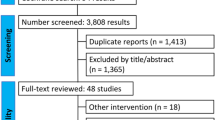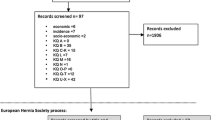Abstract
Purpose
Abdominal compartment syndrome (ACS) is a severe complication of ventral hernia repair. The aims of this study were to investigate the effects of intra-abdominal pressure on the physiologic changes of abdominal wall reconstruction and component separation in a porcine model.
Methods
Ventral hernia repair (VHR) was simulated by abdominal fascial imbrication of a 10 × 15 cm defect in 45 Yorkshire pigs assigned to five experimental groups. ACS was simulated by a Stryker endoscopy insufflator with intra-abdominal pressure elevated to 20 mmHg in two groups. Component separation was performed in one of these groups and in one group without ACS. Physiological parameters were measured before and after the procedures and monitored for 4 h. The animals were euthanized for histologic analysis of organ damage.
Results
VHR led to an increase in intra-abdominal pressure, bladder pressure, and central venous pressure by an average of 14.89, 13.93, and 14.69 mmHg (p < 0.001) in all animals. Component separation was performed in 25 animals and the three pressures reduced by 9.11, 8.00, 7.89 mmHg (p < 0.001). ACS correlated with higher percentages of large and small bowel necrosis compared to groups without abdominal compartment syndrome.
Conclusions
The results confirm that primary repair of large abdominal wall defects leads to increased intra-abdominal pressure, which can be reduced with component separation. In animals with ACS, component separation may reduce the risk of organ damage. Central venous pressure, bladder pressure, and other physiologic parameters accurately correlated with elevated intra-abdominal pressure and may have utility as markers for diagnosis of ACS.





Similar content being viewed by others
References
Christy MR, Apostolides J, Rodriguez ED, Manson PN, Gens D et al (2012) The component separation index: a standardized biometric identity in abdominal wall reconstruction. Eplasty 12:e17
Brenner M, Bochicchio G, Bochicchio K, Ilahi O, Rodriguez E et al (2011) Long-term impact of damage control laparotomy: a prospective study. Arch Surg 146:395–399
Porshinsky B, Ramasastry S (2006) Abdominal wall reconstruction with free flaps. Clin Plast Surg 33:269–280
Disa JJ, Goldberg NH, Carlton JM, Robertson BC, Slezak S (1998) Restoring abdominal wall integrity in contaminated tissue-deficient wounds using autologous fascia grafts. Plast Reconstr Surg 101:979–986
Shestak KC, Edington HJ, Johnson RR (2000) The separation of anatomic components technique for the reconstruction of massive midline abdominal wall defects: anatomy, surgical technique, applications, and limitations revisited. Plast Reconstr Surg 105:731–738 quiz 739
Ramirez OM, Ruas E, Dellon AL (1990) “Components separation” method for closure of abdominal-wall defects: an anatomic and clinical study. Plast Reconstr Surg 86:519–526
Williams JK, Carlson GW, deChalain T, Howell R, Coleman JJ (1998) Role of tensor fasciae latae in abdominal wall reconstruction. Plast Reconstr Surg 101:713–718
Rodriguez ED, Bluebond-Langner R, Silverman RP, Bochicchio G, Yao A et al (2007) Abdominal wall reconstruction following severe loss of domain: the R Adams Cowley Shock Trauma Center algorithm. Plast Reconstr Surg 120:669–680
Agnew SP, Small W Jr, Wang E, Smith LJ, Hadad I et al (2010) Prospective measurements of intra-abdominal volume and pulmonary function after repair of massive ventral hernias with the components separation technique. Ann Surg 251:981–988
An G, West MA (2008) Abdominal compartment syndrome: a concise clinical review. Crit Care Med 36:1304–1310
Buck DW 2nd, Steinberg JP, Fryer J, Dumanian GA (2010) Operative management of massive hernias with associated distended bowel. Am J Surg 200:258–264
Bluebond-Langner R, Keifa ES, Mithani S, Bochicchio GV, Scalea T et al (2008) Recurrent abdominal laxity following interpositional human acellular dermal matrix. Ann Plast Surg 60:76–80
Tobias AM, Low DW (2003) The use of a subfascial vicryl mesh buttress to aid in the closure of massive ventral hernias following damage-control laparotomy. Plast Reconstr Surg 112:766–776
O’Mara MS, Papasavas PK, Newton ED, Caushaj PF (2004) Modified separation of parts as an intervention for intraabdominal hypertension and the abdominal compartment syndrome in a swine model. Plast Reconstr Surg 114:1842–1845
De Santis L, Frigo F, Bruttocao A, Terranova O (2003) Pathophysiology of giant incisional hernias with loss of abdominal wall substance. Acta Biomed 74(Suppl 2):34–37
Acknowledgments
We would like to thank TDMI for their expert animal management and assistance with surgical procedures. We would also like to thank Dr. Cinthia Drachenberg for analyzing the pathological specimens from this study and Dr. Leigh Ann Price for her input on the study design. This study was funded by a Lifecell Grant ISIS.08.01.00.ER.
Conflict of interest
RM declares no conflict of interest. HHC declares no conflict of interest. HDW declares no conflict of interest. AJN declares no conflict of interest. JAK declares no conflict of interest. GSM declares no conflict of interest. MM declares no conflict of interest. ENB declares no conflict of interest. MRC declares no conflict of interest. EDR declares conflict of interest not directly related to the submitted work (Grant—Synthes CMF, KLS Martin; support for travel—Synthes CMF; payment for lectures—CME Outfitters). This study was funded by a grant provided by Lifecell (Grant ISIS.08.01.00.ER). Eduardo D. Rodriguez received MD DDS—Grants (Synthes CMF, KLS Martin) and payments for lectures (Synthes CMF), travel accommodations/expenses for unrelated activities (Synthes CMF).
Ethical Standards
The experiments in this study comply with the current laws of the country in which they were performed.
Author information
Authors and Affiliations
Corresponding author
Additional information
R. Mohan and H. G. Hui-Chou are equally contributed authors.
Rights and permissions
About this article
Cite this article
Mohan, R., Hui-Chou, H.G., Wang, H.D. et al. Physiologic changes with abdominal wall reconstruction in a porcine abdominal compartment syndrome model. Hernia 19, 313–321 (2015). https://doi.org/10.1007/s10029-014-1313-x
Received:
Accepted:
Published:
Issue Date:
DOI: https://doi.org/10.1007/s10029-014-1313-x




